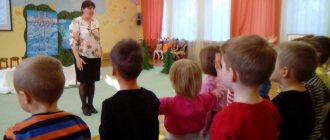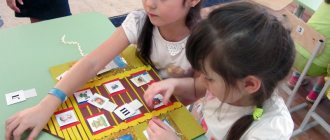Summary of the game - dramatization of "Teremok" in the middle group.
Municipal budgetary preschool educational institution kindergarten No. 107 “Firefly”
Abstract
games - dramatization "Teremok"
in the middle group.
Completed by the teacher:
Chernetsova S. Yu.
Ulyanovsk, 2022
Target
: Creating favorable conditions for creative activity in children through theatrical activities.
Tasks:
1. Cognitive development: teach children to dramatize a familiar work, coordinate the words and actions of a character, continue to introduce the basics of theatrical activity.
2. Speech development: teach children to pronounce words clearly and distinctly, develop intonation expressiveness, promote the development of dialogic speech, develop memory, visual and auditory attention, imaginative thinking, imagination.
3. Physical development: develop the ability to convey the characteristic movements and motor characteristics of characters.
4. Artistic and aesthetic development: develop artistic abilities, musical abilities, dance movements, the ability to imitate the characteristic actions of characters.
5. Socio-communicative development: cultivate politeness, confidence, friendly relations, empathy for each other, encourage interaction with partners.
Integration of educational areas:
cognitive development, speech, social-communicative, artistic-aesthetic, physical.
Preliminary work:
1. Reading the fairy tale “Teremok”.
2. Playing out the plot of a fairy tale in the round dance game “Teremok”.
3. Telling a fairy tale by role.
4. Dramatization of a fairy tale using various types of theater.
5. Examination of illustrations for a fairy tale.
6. Carrying out the didactic game “Collect a fairy tale using a chain of pictures “Teremok”.
7. Individual work to fulfill the role, actions in accordance with the text.
Equipment
: house - mansion, table, chairs for heroes, broom, dishes, cast iron, wooden spoon, flowers in pots, watering can, cloth, balalaika, costumes, masks, refreshments.
Planned results
: Formation of interest in theater in children, development of a culture of speech, emotionality, love for Russian folk tales.
Progress:
Ved: Children, look how many guests came to our performance today. Let's all say hello (children say hello). And now, dear artists, let us take our seats, our fairy tale begins.
Ved: Everyone in the world loves fairy tales, adults and children love them,
Fairy tales teach us kindness and hard work,
They say how to live so that everyone around you can be friends.
The kindergarten will show us Teremok in a new way.
There is a tower-house in a field, it is not low, not high, not high.
No one lives in the tower, no one invites you to visit.
Dramatization game in early preschool age
The play activity of preschoolers is associated with the gradual advancement of the modern preschool child into the space and time of play. In the period from 3 to 6-7 years, with the help of an adult and independently, he/she masters various types of individual and collective games.
Each type of game contributes to the development of cognitive and creative activity, to the formation of the child’s personality and his relationships with the world, and specifically influences the formation of conditions for educational activities as leading ones in the next age period. The game is a kind of “experimental platform” for children of the fourth year of life to get acquainted with the objective and social world, test themselves and determine the boundaries of their capabilities, realize individual needs and demonstrate future abilities.
In order for the community of children of the fourth year of life to become a playful one, targeted pedagogical influence is necessary. The main pedagogical objectives are:
- Helping children acquire gaming skills, enriching their gaming experience;
- expanding children's ideas about objects, events and phenomena of the surrounding world, which can then be reproduced in the game
- Encouraging children's initiative in using individual, pair and group games;
- Creating conditions for children to engage in play activities during the day, etc.
Dramatization games are special games in which the child re-enacts a familiar story, develops it, or invents a new one. It is important that in this game the child creates his own little world and feels like a master, a creator of action. He controls the actions of the characters and builds their relationships. In the game, the kid turns into an actor, as well as a director and screenwriter. In such games, the child never plays silently. Using his own voice or the voice of a character, the child pronounces events and experiences. He or she voices characters, comes up with a plot, experiences things that are not easy for him or her in ordinary life. During such games, intensive speech development occurs, qualitative and quantitative enrichment of the child’s vocabulary, imagination, creative abilities, ability to control oneself, maintain attention in accordance with the action, logical and independent thinking. All this becomes especially important in cognitive development and further educational activities. Therefore, dramatization games are extremely useful and necessary for a child at different stages of his development.
In dramatization games, the content, roles and game actions are determined by the plot and content of a literary work, fairy tale, etc. They are similar to role-playing games: Both of them are based on the conditional reproduction of events, actions, interpersonal relationships, etc., and also have elements of creativity. A feature of theatrical games is that children play certain roles in accordance with the plot of a story or fairy tale, reproducing events in the exact order.
Fairy tales are usually the basis for dramatization games. In fairy tales, the characters are most clearly defined, they attract children with dynamism and clear motivation for actions, actions are clearly separated, and preschoolers love to play in them. Children's favorite folk tales “Turnip”, “Kolobok”, “Trick or Treat”, “Three Bears”, etc. are easily dramatized. Theatrical games use rhymes with dialogues that allow the content to be reproduced in role-playing form.
With the help of dramatization games, children better assimilate the ideological content of the work, the logic and sequence of events, their development and cause-and-effect relationships.
Features of the assimilation of literary text by preschool children
Works of literature contribute to the development of the language and provide examples of the Russian literary language. With the help of the literary word, even before school, even before learning grammatical rules, the child practically learns the grammatical norms of the language in unity with vocabulary. The child learns many new words and figurative expressions from the book, his language is enriched with emotional vocabulary.
A work of art is valuable because it directly affects the child. By creating it, the author, of course, provides the opportunity for the child to independently study the content, achieving emotionality and clarity of the story, where morality naturally follows from the actions and deeds of the characters. Therefore, the goal of many methodological techniques is to facilitate the process of listening and understanding (to help remember the work, to feel it more deeply).
In the introduction to the literary text, a clear connection is made between the development of language and the aesthetic; language is studied in its aesthetic function. Knowledge of the means of linguistic expression serves to develop the artistic perception of literary works.
The tasks and content of introducing children to literature in a preschool setting are determined on the basis of knowledge of the characteristics of perception and understanding of works of literature and are presented in kindergarten programs.
In general terms, these tasks were formulated by methodologists S.I. Karpova and V.V. Mamaev as follows:
- To instill an interest in fiction, develop the ability to holistically perceive works of different genres, ensure the assimilation of the content of the work and an emotional reaction to it;
- form first ideas about the features of fiction
- contribute to the development of literary and artistic taste, the ability to understand and feel the mood of a work, to capture the musicality, sonority, rhythm, beauty and poetry of works, to develop a poetic ear.
Children also develop the ability to elementary analyze the content and form of a work.
The perception of fiction is considered as an active volitional process, including passive contemplation and activity, embodied in internal assistance, empathy for characters, imaginary transfer of events to oneself, “mental action”, the effect of personal presence, personal participation in events is created.
O.S. Ushakova and O.I. Nikiforov distinguishes three stages in the development of perception of a work of art: “direct perception, reconstruction and experience of images (based on the work of the imagination); understanding the ideological content of the work (based on thinking); the impact of fiction on the teacher’s personality (through feelings and consciousness).”
A child's perception of art in preschool age develops and improves. L.M. Gurovich, based on a generalization of scientific data and his own research, examines the age-related characteristics of preschoolers’ perception of literary works and identifies “two periods in their aesthetic development: from 2-5 years, when the child does not yet clearly separate life from art, and after five years “when art, including language arts, becomes valuable in itself for a child.”

